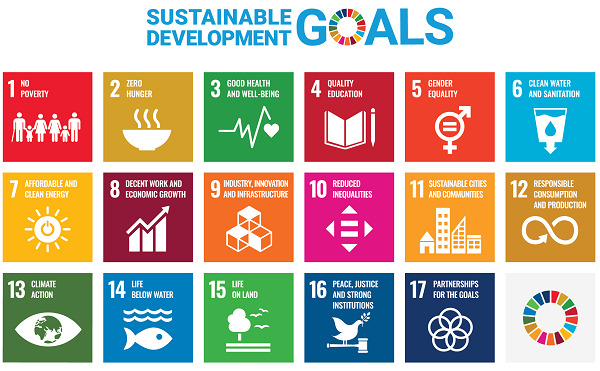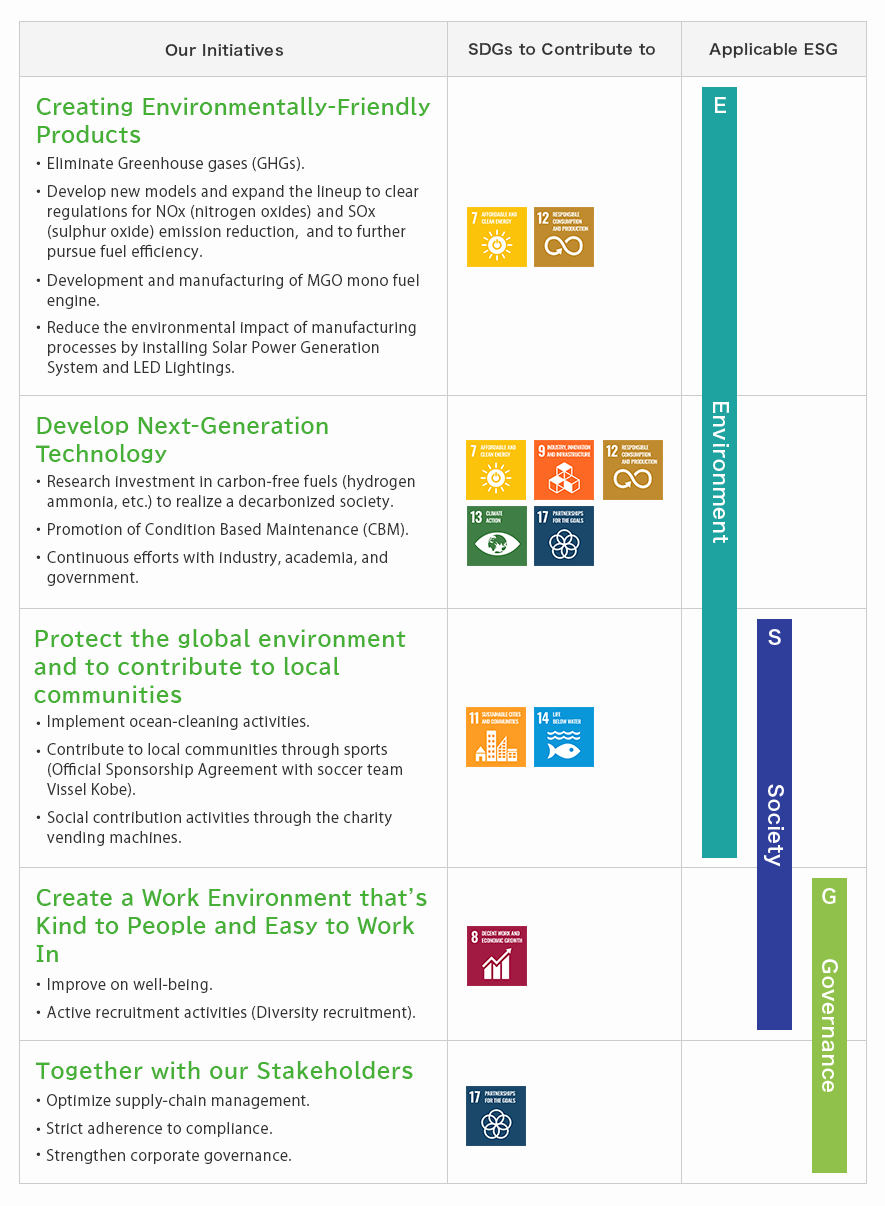SDGs
Our SDGs Action Initiatives
As one of our corporate management philosophies is “contribute to the development of society and industry,” we are taking initiatives such as developing fuel-efficient engines that realize an efficient usage of natural resources, advanced fuel conversion research towards the goal of zero emissions, and activities to clean up the oceans.
These initiatives are our efforts to contribute to the realization of the 17 Sustainable Development Goals (SDGs), the action plan for the prosperity of mankind and the earth to be achieved by 2030, adopted by the United Nations in 2015. Our goal is to realize a sustainable society.


Examples of Our Initiatives
Developing, designing, and manufacturing an engine which clears environmental regulations and strives for even lower fuel consumption

UE engine that we have independently developed has the advantage of a low fuel consumption rate that surpasses our competitors. We will further continue to pursue this strength, with the goal of contributing to CO2 reduction through the efficient usage of natural resources. 42LSH engine which succeed our best-selling 45LSE engine, will seek even greater ultra-low fuel consumption. The optimal output range has been set for handy-size bulk carriers and small chemical carriers at shipyards both domestically and internationally. The first set of this engine, which meets the IMO*1’s regulations for NOx*2 and SOx*3 and contributes to clearing the EDDI*4, was completed in March 2021. After that 33LSH engine has been released and the first set was completed in September 2022. We will continue to develop new engines and expand our lineup in order to contribute to the efficient usage of natural resources.
Reducing the environmental impact of manufacturing processes

Photovoltaic power generation facilities were installed on the rooftops of two office buildings and two warehouses at our headquarters, and began operation on January 31, 2023. The facilities are expected to generate 589,020 kWh of electricity annually, and to reduce CO2 emissions by 181 tons per year.In addition, we are replacing all the ceiling lights at plant buildings, offices, and warehouses with LED lights.These efforts can realize reduction of environmental impact and improvement of working environment by optimizing illumination.
We are also working on reducing environmental impact in all of our business activities, includingmanufacturing processes in addition to the contribution through providing our products, such as the advanced engines with high fuel efficiency and the development of ammonia and hydrogen fuel engines and so on.
Developing and Manufacturing Engines of a Low Fuel Consumption Rate That Use Only Fuel with Low Sulfur Content

In order to clear the global cap of SOx*3 below 0.5% emission control from ships that IMO*1 has started to apply since 2020, we developed the LSJ series of engines in 2018 that use only MGO*5 with low sulfur content as fuel. This engine can balance life-cycle costs, reduce the environmental load, and ensure economic efficiency by balancing the relatively-high cost of using high-quality fuel with lower fuel consumption, reducing peripheral equipment, and reducing maintenance costs. We will contribute to the environment by using this engine. We have developed the UEC35LSJ engine with a 35 cm cylinder bore, the first set of wihch was completed in July 2022 in succession from the 50 cm cylinder bore engine whose design has been established. In addition, UEC42LSJ with 42 cm cylinder bore is under development. Increasing number of applicable ship types by enhancing variations of LSJ series will be in our goal of making further contributions to the environment.
Continued Investments in Combustion Research for Carbon-Free Fuels such as Bioorganic, Hydrogen, and Ammonia

As the need for research and practical applications of alternative fuels without carbon is accelerating accelerates, we are participating in the development of engines using the decarbonized fuels of ammonia and hydrogen. Additionally, the usage of decarbonized fuels is expected to reduce or eliminate GHG*(6) emissions. Cooperation between many related agencies, organizations, and companies is indispensable for the research and commercialization of fuel conversion. Through these partnerships, we will contribute towards a decarbonized society.
Promotion of Condition Based Maintenance (CBM)
As the transmission of large capacity of data between ships and land has become possible due to advancements in ICT, the needs of Condition Based Maintenance (CBM) are increasing as a maintenance standard instead of Time Based Maintenance (TBM)*8. Since the summer of 2017 we have been researching together with other companies in order to establish CBM. As a result, we signed a joint research agreement in November 2019 with one classification society and two private enterprises. We will promote the construction of a new ship classification inspection system based on CBM in order to expand technological innovation.
Continued Participation in Industrial/Academia/Government Collaborative Initiatives Led by the Japanese Government

The International Shipping GHG Zero Emissions Project, launched in 2018, is an activity that examines and adjusts the overall strategies for GHG reduction in Japan, in collaboration with industry, academia, and the Japanese government. The project aims to achieve such goals proposed by the IMO*1 as ‘40% or more improvement in efficiency by 2030,’ ‘halve GHG*5 by 2050,’ and ‘zero emissions as quickly as possible during this century.’ We are participating in this project as a member of the Japan Ship Machinery and Equipment Association, and we will continue to participate in activities to prevent global warming in a unified effort with industry, academia, and the government.
Implementing Ocean litter Clean-Up Activities

For us, as the ocean is one of our fields, the problem of plastic garbage in the ocean, such as bottles and bags, is a social problem that cannot be overlooked. We endorse ‘Zero Marine Litter Week,’ a joint project of the Nippon Foundation and the Ministry of the Environment, that regularly conducts clean-up activities at nearby beaches from 2019.
Every year managing staff and employees from our company participated in a 2-hour clean-up activity at the Nishioka Seaside Park (in Akashi-city, Hyogo prefecture, a beach that’s a 20-minute walk from our offices). We collected 87 bags of garbage, with contents such as plastic bottles and lunch boxes.
Create a Work Environment that’s Kind to People and Easy to Work In

We strive to realize a comfortable work place and diverse work style where all employees can participate in various activities at their home and in local communities, while fulfilling their work duties and gaining a sense of satisfaction from their work. We are supporting the self-fulfillment of each employee, with our policies of promoting paid leave, and establishing a system that allows employees to work according to their circumstances and lifestyle, such as childbirth, childcare, and nursing care.
Also, in addition to our continued active recruitment activities and our efforts to create employment opportunities for local communities, in consideration of the difficulties in securing human resources due to the declining birthrate, we will seek to secure human resources by employing foreign nationals and considering elderly employment extension, as well as plan for the smooth transfer of skills.
Contributing to SDGs Together with our Stakeholders

In order to achieve sustainable growth, we believe that multi-stakeholder partnerships with all our stakeholders, including investors and the supply chain, are important. For this reason, we place importance in disseminating information to everyone while ensuring thorough compliance and enhancing corporate governance. Additionally, we will realize our contributions to the achievement of the SDGs by further strengthening our supply chain, deepening our relationships with our business partners, creating new innovations, and further developing our environmentally-friendly technologies, which is one of our strongest points.
Glossary
1: The International Maritime Organization (IMO) is a specialized United Nations organization, responsible for creating treaties and standards for the improvement of marine navigation safety, marine technology, and the prevention of marine pollution.
2: Nitrogen oxides (NOx) is a general term for nitrogen and oxygen compounds. Most of the nitrogen oxides in the atmosphere are nitrogen monoxide (NO) and nitrogen dioxides (NO2). These are the substances generated by the combustion of oil and coal, and are considered to be the cause of air pollution and acid rain.
In the shipping industry, the amount of NOx that is emitted from ships is regulated by the MARPOL (International Convention for the Prevention of Pollution from Ships) Convention Annex IV (Air Pollution Prevention), an international treaty that prevents marine pollution from ships.
3: Sulfur oxides (SOx) are substances generated by the combustion of sulfur-containing petroleum or coal, causing air pollution and acid rain. The upper limit of the sulfur content in fuel is being gradually reduced in order to reduce SOx emissions. After January 2020, the sulfur content in used fuel will be limited to 0.5% in many ocean areas, with the exception of regulated ocean areas.
4: The Energy Efficiency Design Index (EEDI) is a value that indicates the amount of CO2 emitted when a ton of cargo is carried one nautical mile. IMO’s 62nd Marine Environment Protection Committee adopted the EEDI in July 2011 as a mandatory measure against global warming.
5: An abbreviation for marine gas oil. Marine Diesel Oil (MDO), also called A heavy oil in Japan, is a high-quality, eco-friendly fuel compared to “C” heavy oil, that has been used in marine diesel engines. For more details, check out /product/lsj.html
6: Greenhouse Gases (GHG) are gases such as tropospheric ozone, carbon dioxide, and methane, which are the main cause of global warming. The GHG reduction strategy was adopted by the International Maritime Organization, with the goals such as ‘Improve transport efficiency by 40% compared to 2008 by 2030'‘reducing GHG emissions by half by 2050, based on the vision of ‘achieving zero GHG emissions from international shipping at the earliest possible time in this century'
7: Condition Based Maintenance (CBM)
Efficient operation by replacing only parts that require maintenance by using ICT to monitoring the parts actual condition. In realizing optimal maintenance based on the condition, maintenance time and costs can be reduced, as well as contributing to the safe operation of ships through condition monitoring.
8: Time Based Management (TBM)
Standard maintenance method that is performed at fixed intervals regardless of the condition of the parts.
